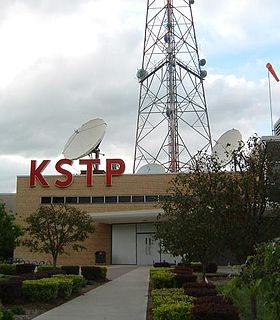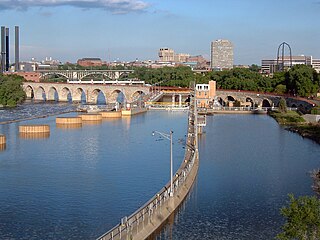| Look up Minneapolis in Wiktionary, the free dictionary. |
Minneapolis is the most populous city in the U.S. state of Minnesota.
Minneapolis may also refer to:
| Look up Minneapolis in Wiktionary, the free dictionary. |
Minneapolis is the most populous city in the U.S. state of Minnesota.
Minneapolis may also refer to:
| This disambiguation page lists articles about distinct geographical locations with the same name. If an internal link led you here, you may wish to change the link to point directly to the intended article. |

Minnesota is a state in the Upper Midwest, Great Lakes, and northern regions of the United States. Minnesota was admitted as the 32nd U.S. state on May 11, 1858, created from the eastern half of the Minnesota Territory. The state is known as the "Land of 10,000 Lakes". Its official motto is L'Étoile du Nord.

Saint Paul is the capital of the U.S. state of Minnesota. It is the county seat of Ramsey County, the state's smallest and most densely populated county. As of 2019, its estimated population was 308,096, making it the 63rd-largest city in the United States and the 11th-most populous in the Midwest. Most of the city lies east of the Mississippi River at the confluence with the Minnesota River. Minneapolis, the state's largest city, is across the river to the west. Together they are known as the "Twin Cities". They are the core of Minneapolis–Saint Paul metropolitan area, home to over 3.6 million and the third-largest in the Midwest.

Ramsey County is a county located in the U.S. state of Minnesota. As of the 2010 census, the population was 508,640, making it the second-most populous county in Minnesota. Its county seat and largest city is St. Paul, the state capital. The county was founded in 1849 and is named for Alexander Ramsey, the first governor of the Minnesota Territory.

Hennepin County is a county in the U.S. state of Minnesota. As of the 2010 census the population was 1,152,425. It is the most populous county in Minnesota and the 32nd-most populous county in the United States; more than one in five Minnesotans live in Hennepin County. Its county seat is Minneapolis, the state's most populous city. The county is named in honor of the 17th-century explorer Father Louis Hennepin. Hennepin County is included in the Minneapolis-St. Paul-Bloomington Metropolitan Statistical Area. The center of population of Minnesota is in Hennepin County, in the City of Minneapolis.

Minneapolis–Saint Paul is a major metropolitan area built around the Mississippi, Minnesota and St. Croix rivers in east central Minnesota. The area is commonly known as the Twin Cities after its two largest cities, Minneapolis, the most populous city in the state, and its neighbor to the east Saint Paul, the state capital. It is an example of twin cities in the sense of geographical proximity. Minnesotans living outside of Minneapolis and Saint Paul often refer to the two together simply as "the Cities".

Fridley is a city in Anoka County, Minnesota, United States. The population was 27,208 at the 2010 census. Fridley was incorporated in 1949 as a village and became a city in 1957. It is part of the Twin Cities Metropolitan Area. Fridley is a "first ring" or "inner ring" suburb in the northern part of the Twin Cities. Fridley connects with the city of Minneapolis at its southern border. Neighboring first ring suburbs are Columbia Heights to the South and Brooklyn Center to the West across the Mississippi river.

The history of the U.S. state of Minnesota is shaped by its original Native American residents, European exploration and settlement, and the emergence of industries made possible by the state's natural resources. Minnesota achieved prominence through fur trading, logging, and farming, and later through railroads, and iron mining. While those industries remain important, the state's economy is now driven by banking, computers, and health care.
There are 13 U.S. cities with teams from four major sports, where "city" is defined as the entire metropolitan area, and "major professional sports leagues" as:

University Avenue is a street that runs through both Minneapolis and Saint Paul, Minnesota. It begins near the Minnesota State Capitol in Saint Paul and extends westward into neighboring Minneapolis, where it passes the University of Minnesota, and then turns north to pass through several suburbs before its main portion ends in Blaine, Minnesota, although there are stretches of road designated as University Avenue that are north of the Blaine terminus, the final stretch ending near Andree, Minnesota. For many years, the road carried U.S. Highway 12 and U.S. Highway 52, and University Avenue is still a significant thoroughfare in the area.

Minneapolis is the largest and most-populous city in the U.S. state of Minnesota and the seat of Hennepin County, the state's most-populous county. As of 2019, Minneapolis has an estimated population of 429,606, making it the 46th-largest city in the United States, the 8th-largest in the Midwestern United States, and the second-most densely populated large city in the region behind Chicago. Minneapolis and its neighbor Saint Paul make up the Twin Cities, with Minneapolis being the larger of the two. The Twin Cities metro and their surrounding suburbs contain about 3.64 million people, making it the third-largest economic and population center in the Midwest and the 16th-largest metropolitan area in the United States.

Transportation in the U.S. State of Minnesota consists of a complex network of roadways, railways, waterways and airports. The transportation system is generally overseen by the Minnesota Department of Transportation, a cabinet-level agency of the state government. Additionally, regional governments such as the Metropolitan Council have authority over regional planning for the transportation system and local governments such as cities and counties oversee the local transportation network.

Minnesota is the northernmost state outside Alaska; its isolated Northwest Angle in Lake of the Woods is the only part of the 48 contiguous states lying north of the 49th parallel. Minnesota is in the U.S. region known as the Upper Midwest. The state shares a Lake Superior water border with Michigan and Wisconsin on the northeast; the remainder of the eastern border is with Wisconsin. Iowa is to the south, North Dakota and South Dakota are west, and the Canadian provinces of Ontario and Manitoba are north. With 87,014 square miles (225,370 km2), or approximately 2.26 % of the United States, Minnesota is the 12th largest state.
U.S. Highway 52 enters the state of Minnesota at the unincorporated community of Prosper, north of the town of Burr Oak, Iowa. The route is marked north–south in Minnesota along its independent segment from the Iowa state line to downtown St. Paul. Highway 52 is not signed along the length of its concurrency with Interstate 94 (I-94) from downtown St. Paul to the North Dakota state line at Moorhead and Fargo.

Minnesota United FC are an American professional soccer club based in Saint Paul, Minnesota that plays in the Western Conference of Major League Soccer. The club began play in 2017 as the league's 22nd club, and replaced the North American Soccer League (NASL) franchise of the same name.

U.S. Bank Stadium is an enclosed stadium in Minneapolis, Minnesota, United States. Built on the former site of the Hubert H. Humphrey Metrodome, the indoor stadium opened in 2016 and is the home of the Minnesota Vikings (NFL); it also hosts early season college baseball games of the University of Minnesota Golden Gophers (NCAA).

The following outline is provided as an overview of and topical guide to the U.S. state of Minnesota:
Bicycling has been a popular activity in Minnesota since the late 19th century. Since at least 2001, the state has claimed to have more miles of bike trails than any other in the U.S. For 2017, Minnesota was ranked as the 2nd most bicycle-friendly state by the League of American Bicyclists, moving up from its 5th-ranked position in 2008 and 2009. It was only exceeded by Washington. Much of the state's bicycle culture is centered in Minneapolis, the state's largest city, but the extensive network of trails has helped make cycling common throughout the state.

The 2016 United States presidential election in Minnesota was held on November 8, 2016, as part of the 2016 United States presidential election in which all fifty states and the District of Columbia participated. The state was won by Hillary Clinton.

Fort Snelling is an unorganized territory of Hennepin County, Minnesota, United States named after historic Fort Snelling, located within its boundaries. The territory also includes Minneapolis-Saint Paul International Airport and various government facilities, and as of the 2010 census had a population of 149.